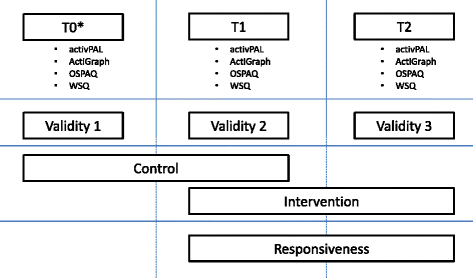Validity and responsiveness of four measures of occupational sitting and standing
- PMID: 26608219
- PMCID: PMC4660635
- DOI: 10.1186/s12966-015-0306-1
Validity and responsiveness of four measures of occupational sitting and standing
Abstract
Background: Evidence on the detrimental health effects of prolonged sedentary behavior is accumulating. Interventions need to have a specific focus on sedentary behavior in order to generate clinically meaningful decreases in sedentary time. When evaluating such intervention, the question whether a participant improved or deteriorated their behavior is fundamental and instruments that are able to detect those changes are essential. Therefore, the aim of this study was to determine the criterion validity against activPAL and responsiveness to change of two activity monitors (ActiGraph and activPAL) and two questionnaires for the assessment of occupational sitting and standing time.
Methods: 42 participants took part in the Stand@Work intervention trial. Six (T0) and two (T1) weeks before they received a sit-stand workstation and three weeks thereafter (T2), participants wore an ActiGraph and an activPAL activity monitor, and completed the Occupational Sitting and Physical Activity Questionnaire (OSPAQ) and the Workforce Sitting Questionnaire (WSQ). The activPAL was used as the criterion validity measure.
Results: The ActiGraph showed strong validity for occupational sedentary time at T0 and T1 (Spearman rho = 0.77 and 0.69), but its validity dropped substantially after introduction of the sit-stand workstation (rho = 0.19). Correlations between occupational light-intensity activity assessed by the ActiGraph and occupational standing time assessed by the activPAL varied between 0.25-0.63. The occupational sitting validity correlation of the OSPAQ and WSQ varied from 0.35-0.48 and 0.25-0.30, respectively, and between 0.16-0.68 for the OSPAQ for occupational standing time. The intervention-induced changes in occupational sitting and standing time were well detected by the activPAL, OSPAQ and WSQ (sitting only), but not by the ActiGraph, which had the lowest responsiveness to change.
Conclusions: This study suggests that studies aimed at determining differences in occupational sitting and standing time should use activPAL-type inclinometers as a preferred type of objective measure. Simple questionnaires showed sufficient validity and are usable in addition to an objective measure or alone when objective monitoring is not possible. The hip-worn ActiGraph was unable to distinguish between occupational sitting and standing time, when using uniaxial data and traditional cut-points for sedentary time and light-intensity activity.
Trial registration: The study was registered with the Australian New Zealand Clinical Trials Registry (No. ACTRN 12612000072819).
Figures


References
Publication types
MeSH terms
Associated data
LinkOut - more resources
Full Text Sources
Other Literature Sources
Medical

